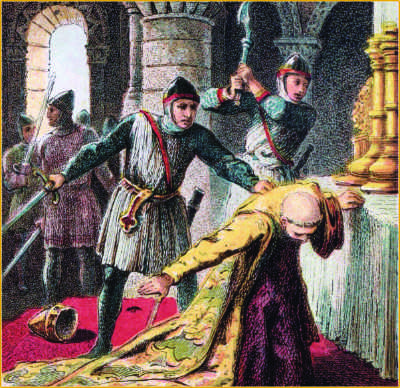In 1180 a wealthy Norman merchant, who was also Lord of the Manor of Titchfield, gave some land in the new town of Portsmouth for a chapel to be built in honour of St Thomas Becket, the Archbishop of Canterbury who had been murdered just 10 years earlier. In the 14th century this chapel became a parish church and in 1927 the Cathedral of the newly established Diocese of Portsmouth.
Yesterday was the 850th anniversary of the murder of St Thomas Becket, and it seems to be appropriate to say a few words about him today, not least because it is to him that our cathedral, the mother church of the diocese is dedicated.
We actually know quite a bit about his life because of the number of contemporary biographers of Thomas, one of whom was a member of his staff and his household by the name of Herbert of Bosham, named so because it is thought he was born in Bosham, just along the coast from here.
In Cheapside in the City of London there is a blue plaque on a building to denote the site of a house in which he was born around the year 1120 (the actual building long since demolished). His parents, Gilbert and Matilda were French and had emigrated from Normandy sometime after the Norman conquest. Gilbert was a merchant, well connected but not particularly wealthy. But it was through his connections that after his education at Merton Priory and in the Parish, Thomas found employment with Theobald, the Archbishop of Canterbury. Theobald recognised the young man’s talents and suggested to Henry II that he appoint Thomas as Chancellor of England, which he duly did in 1155. By then Thomas had already been ordained deacon and had served in a variety of ecclesiastical offices, including that of Archdeacon of Canterbury.
Becket and the king soon became close friends and Thomas embraced life in the royal court. Contemporaries noted his vast wealth and lavish parties, decorating his residences with fine furnishings, mostly obtained in France during his numerous journey there made in his own ships.
His lifestyle was not really that which one might associate with being a priest in God’s Church.
When the position of Archbishop of Canterbury became vacant following the death of Theobald in April 1161, Henry II put Thomas forward as a candidate. Doubtless he thought this would be a good way of controlling the church and state having his good friend as Archbishop of Canterbury and Chancellor of England. Becket was duly appointed on 23 May 1162. He was ordained priest on 2nd June and consecrated as Archbishop the day after.
It could be argued that his lifestyle and his reputation hardly made him an ideal candidate for the role, but once consecrated something remarkable happened. He seems to have abandoned his old life becoming instead an ascetic. Within a few months he resigned the position of Lord Chancellor, against the wishes of the king. Gradually the relationship between king and archbishop deteriorated, not least because Thomas refused to acquiesce to the king’s wish to control the church. Eventually Thomas fled to France where he lived in exile for six years.
In the end the Pope put pressure on the king to allow Thomas back and to restore his rights as Archbishop of Canterbury.
But things were not to end well.
In June 1170, at the kings behest, the Archbishop of York (a long time adversary of Thomas) along with the Bishop of London and the Bishop of Salisbury, crowned the heir apparent, Henry the Young King, at York. This was a clear breach of Canterbury’s privilege. One of Thomas’s final acts was to excommunicate all three bishops. It was at this point that Henry II is alleged to have uttered the words: ‘Who will rid me of this turbulent priest’. Whether he did say these words or something similar is disputed, but what is beyond doubt is that four knights travelled to Canterbury in pursuit of Thomas.
His martyrdom is well recorded by five monks who were with him in the Cathedral when he was apprehended. One of them, Edward Grim, was so close that he was himself injured by one of the knight’s swords. Thomas was murdered brutally in his Cathedral on 29th December 1170.
In one of the fastest canonisations in history Thomas was declared a saint on 21st February 1173, following an extraordinary wave of miracles that were recorded. In 1174, in a public act of penance for his involvement in Becket’s death, Henry II paid homage to the tomb of St Thomas and soon the shrine became one of the principal places of pilgrimage in Europe, as evident in Chaucer’s fictional account of pilgrims in his Canterbury Tales.
Today, as we give thanks for the witness of Thomas unto death, we pray for all those who have been martyred for their faith. We pray for our diocese, for Christopher our Bishop, Antony Cane, Dean of Portsmouth cathedral, and for its ministry and mission.
Fr Dr Colin Lawlor






